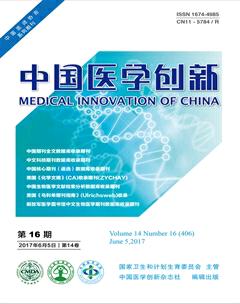冠心病合并慢性肾病3期患者冠状动脉病变特点探讨
伍伟铭 陈永宣

【摘要】 目的:探讨冠心病合并慢性肾病3期患者冠状动脉病变的特点。方法:选取汕头大学医学院附属第二医院2012年1月1日-2013年4月18日行冠脉造影术确诊冠心病的119例患者,按照慢性肾病(CKD)分期标准,合并CKD 3期的40例患者为观察A组,未合并CKD 3期的79例患者為对照A组。根据造影结果了解两组冠状动脉病变支数情况,对比两组冠脉病变总体狭窄程度。选取2012年1月1日-2013年1月31日的140例行冠状动脉CTA患者,其中CKD3期患者40例为观察B组,CKD1~2期患者100例为对照B组。根据CTA分析各组冠状动脉斑块钙化积分、发现斑块和严重斑块率、斑块类型的特点。结果:冠脉造影结果,观察A组与对照A组比较,三支冠脉病变例数多、总狭窄积分高,差异均有统计学意义(P<0.05);两组单支、双支冠脉病变数比较,差异均无统计学意义(P>0.05)。冠脉CTA结果,观察B组与对照B组比较,冠状动脉钙化积分高,冠脉斑块发现率高,严重斑块发现率高,钙化斑块比例高,差异均有统计学意义(P<0.05);但两组间混合斑块及非钙化斑块比较,差异无统计学意义(P>0.05)。结论:冠心病合并CKD 3期者与肾功能正常者比较:在冠状动脉造影结果中,冠脉病变支数多,复杂病变多,冠脉狭窄程度重;在冠状动脉CTA结果中,冠脉钙化积分高,发现斑块率及钙化的斑块所占比例高,但两组间混合斑块及非钙化斑块比较无差异。
【关键词】 冠状动脉粥样硬化心脏病; 慢性肾脏病3期; 冠状动脉造影; 冠状动脉CTA
Disscusion of Coronary Artery Lesions Features of Coronary Atherosclerosis Heart Disease Patients Combined with Chronic Kidney Disease 3 Stage/WU Wei-ming,CHEN Yong-xuan.//Medical Innovation of China,2017,14(16):013-016
【Abstract】 Objective:To discussion the coronary artery features of coronary atherosclerosis heart disease patients combiened with chronic kiney disease(CKD) stage 3.Method:From January 2012 to April 2013,119 cases of patients were chosen in the second affiliated hospital,Shantou university medical college,whom had underwent coronarography 119 patients were divided into two groups:79 cases with normal renal function were control A group,whose eGFR≥60 mL/(min·1.73 m2), combined CKD 3 stage of 40 cases were observation A group,whose eGFR was 30-59 mL/(min·1.73 m2).From January 2012 to January 2013,140 patients who underwent coronary CT angiography were selected,40 patients of CKD stage 3 were observation B group,100 patients of CKD stage 1-2 were control B group.The coronary calcification score,coronary plaques quantity,coronary plaques severity,coronary plaques characteristics of all groups according the CTA imaging were analysed.Result:The results of coronary angiography,compared with control A group,in observation A group the cases of three coronary stenosis was more,the total coronary artery stenosis score was higher,the differences were statistically significant(P<0.05);comparison of two groups of single and double vessel coronary artery disease,there were no significant differences(P>0.05).CTA coronary angiography results, compared with control B group,in observation B group the coronary artery calcification score,coronary plaque detection rate,serious plaques found rate,and proportion of calcified plaque were higher,the differences were statistically significant(P<0.05);but compared the two groups of mixed plaque and non calcified plaques,the differences were not statistically significant(P>0.05).Conclusion:CAD combined CKD 3 stage patients has more quantity and more complex coronary artery lesions than who has normal renal function,the lesions also serious than who has normal renal function.Patients with CKD 3 stage had higher calcium score and higher proportions of calcified plaques,while the mixed and non-calcified plaques are no significant differencescompared to patients without CKD 3 stage.
【Key words】 Coronary atherosclerosis heart disease(CAD); Chronic kidney disease(CKD) 3 stage; Coronary arteriography; Coronary CT angiography
First-authors address:Peoples Hospital of Xinhui District in Jiangmen City,Jiangmen 529100,China
doi:10.3969/j.issn.1674-4985.2017.16.004
冠心病指由于冠狀动脉粥样硬化使管腔狭窄导致心肌缺血的心脏病。慢性肾脏病是各种原因导致肾小球滤过率(GFR)<60 mL/(min·1.73 m2)超过3个月的肾病的临床统称。两者关系密切,在14 527名心肌梗死出现心功能不全患者中,33.6%的患者合并慢性肾功能不全[1]。慢性肾脏病为冠心病的独立危险因素[2-3]。患者GFR<60 mL/min时有加快多支心脏血管病变的倾向。临床实验已经证实血肌酐水平与心血管事件的死亡风险存在关联[4-7]。追踪观察发现,GFR下降是冠状动脉病变及心血管不良事件的独立预测因素[8-9]。目前关于慢性肾脏病与冠状动脉病变情况的关系研究少。冠脉造影是最准确显示冠脉的检查手段。而冠脉CTA血管狭窄发现率高,可观察血管壁病理改变,是一项安全快速的检查[10-11]。本文就冠心病合并慢性肾病3期患者在冠脉造影及冠脉CTA检查结果上的病变特点做探讨。
1 资料与方法
1.1 一般资料 选取2012年1月1日-2013年4月18日在汕头大学医学院第二附属医院住院行冠状动脉造影术诊断为冠心病的119例患者为研究对象,根据空腹测血肌酐值使用CKD-EPI公式计算肾小球滤过率估算值(eGFR),按照美国肾脏基金会制订的K/DOQI指南中慢性肾脏病分期,按eGFR值分为30~59 mL/(min·1.73 ㎡)为慢性肾病肾功能3期(CKD3期)患者。合并CKD3期40例患者为观察A组,未合并CKD3期79例患者为对照A组。选取2012年1月1日-2013年1月31行冠状动脉CTA患者140例,按eGFR值,合并CKD3期40例患者为观察B组,未合并CKD3期100例患者为对照B组。
1.2 纳入标准 (1)行冠状动脉造影术诊断冠心病患者,诊断标准:左主干、左前降支、回旋支、右冠状动脉至少有一支管腔直径狭窄程度≥50%。(2)住院疑诊冠心病行冠脉CTA检查患者。肾小球滤过率CKD-EPI计算公式:GFR=a×(Scr/b)c×(0.993)age,Scr:血肌酐(mg/dL);a值:男141,女144;b值:男0.9,女0.7;c值:男性血肌酐≤0.7 mg/dL时取-0.411,>0.7 mg/dL时取-1.209;女性血肌酐≤0.7 mg/dL时取-0.329,>0.7 mg/dL时取-1.209[12-13]。
1.3 方法
1.3.1 临床资料 收集两组患者性别、年龄及有无吸烟史、高血压、糖尿病史、冠心病家族史。空腹检测两组患者血肌酐,血脂[总胆固醇(TC),甘油三酯(TG),高密度脂蛋白胆固醇(HDL),低密度脂蛋白胆固醇(LDL)],纤维蛋白原,血糖及C反应蛋白水平;收集两组冠脉造影的结果,根据冠脉CTA得出斑块钙化积分、斑块及严重斑块发现率、斑块的类型。
1.3.2 冠状动脉造影 各例行冠状动脉造影用GE公司造影机采集、储存及处理图像,取2个不同体位以上图像分析。(1)按照左主干、左前降支、回旋支、右冠状动脉管腔狭窄超过50%的支数分为单支、双支及三支病变[14]。(2)参照Gensini评分系统计算冠状动脉狭窄积分[15],各支积分和为各例患者冠脉狭窄的最终积分。
1.3.3 冠脉CTA 仪器及扫描程序设定:用美国G E64排CT,在0°和90°两次胸部定位像扫描。钙化积分扫描时扫描范围自心底至心尖部进行钙化积分计算。图像后处理:扫描结束后将患者的原始数据进行重建。分别重建出左主干、左前降支、回旋支、对角支、右冠状动脉[16-18]。图像质量评价及冠脉狭窄程度:根据美国心脏协会冠状动脉12段分法进行节段分析,狭窄部位与相近正常血管管腔百分比<50%为正常或轻度狭窄、50%~75%为中度狭窄、>75%为重度狭窄。斑块CT值为非钙化斑块(14±26)HU,(91±21)HU为混合斑块,(419±194)HU为钙化斑块[19-20]。
1.4 统计学处理 使用SPSS 19.0软件进行统计学分析,计量资料用(x±s)表示,比较采用t检验;计数资料以率(%)表示,比较采用 字2检验,P<0.05为差异有统计学意义。
2 结果
2.1 两组患者冠脉造影结果
2.1.1 两组患者冠心病危险因素比较 计算相对危险度(OR值),自变量X:性别、冠心病史、高血压史、吸烟史、糖尿病史共5个因素为自变量(Xi),并给各分类变量赋值。因变量Y:冠心病合并CKD3期赋值1,不合并CAD3期者赋值0,见表1。两组患者的年龄、性别、血压、吸烟、血糖、血脂常规、C反应蛋白比较差异均无统计学意义(P>0.05)。
2.1.2 两组患者冠脉病变支数比较 两组患者单支病变、双支病变例数比较,差异均无统计学意义(P>0.05);但观察组三支病变例数高于对照组,差异有统计学意义(P<0.05),见表2。
2.1.3 两组冠脉狭窄程度比较 观察一组冠状动脉狭窄积分为(54.67±34.57)分,高于对照一组(41.01±35.21)分,两组比较差异有统计学意义(t=2.010,P<0.05)。
2.2 两组患者冠脉CTA检查结果
2.2.1 两组患者易患因素比较 两组患者的年龄、性别、血压、吸烟、血糖、血脂常规等比较差异均无统计学意义(P>0.05)。
2.2.2 两组患者冠脉钙化积分比较 观察组冠脉钙化积分为(158±71.6)分,高于对照组的(95±50.6)分,比较差异有统计学意义(P<0.05)。
2.2.3 两组患者斑块及管腔狭窄>70%的严重斑块情况比较 观察组中发现冠状动脉斑块29例(72.5%),对照组为54例(54.0%),两组比较差异有统计学意义(P<0.05)。观察组测得其OR值(OR=ad/bc)为1.34,OR值的95%可信区间(1.011,4.987),对照组为参考值1.00,可认为合并CKD3期是发现冠状动脉斑块的危险因素。观察组的冠脉斑块阳性率是对照组的1.34倍,分析两组管腔狭窄>70%的严重斑块的阳性率,可知观察组患者较对照组患者冠状动脉更易发现斑块,且管腔狭窄>70%的严重斑块也更容易发现。见表3。
2.2.4 两组患者的斑块形态分型比较 观察组患者发现钙化斑块比例高于对照组,差异有统计学意义(P<0.05),但两组混合斑块和非钙化斑块比较差异均无统计学意义(P>0.05),見表4。
3 讨论
国内外医学研究发现:肾脏疾病3期或以上有加速冠状动脉粥样硬化的发展。eGFR下降是存在冠状动脉血管病变及发生主要心血管不良事件的独立预测因素。所有诊断冠心病的方法中,冠状动脉造影术是目前最可靠的方法和最主要的手段,可直观地了解冠状动脉的直径、走行、分布和形态。然而冠状动脉动脉造影也存在不足,其最大的缺陷就是不能显示血管壁的病理改变,但冠状动脉粥样硬化的基础病理改变恰恰是血管壁的改变,而且其检查费用昂贵,又属于有创检查,存在一定风险。而冠状动脉CTA可以弥补上述缺点,对于有冠心病症状及危险因素者了解冠状动脉粥样硬化情况有较大的帮助。CKD3期和冠状动脉病变关系的具体病理生理机制尚不确切,本文观察组与对照组之间性别、年龄、吸烟、血压、血脂、血糖等方面比较差异均无统计学意义,而观察A、B组冠状动脉病变较对照A、B组明显,因此也可能说明合并CKD3期与冠状动脉病变支数及斑块数目、狭窄程度相关。但非钙化和混合斑块的存在无明显差异,可考虑肾功能不全引起心血管疾病可能是由于影响冠状动脉的狭窄程度为主,而不是使不稳定斑块增多或诱使斑块破裂引起心血管事件。
综上所述,冠状动脉粥样硬化性心脏病合并慢性肾病3期患者比肾功能轻度减退或正常的冠心病患者冠状动脉病变的支数多、复杂的病变多,冠脉狭窄程度更严重。慢性肾脏病3期合并冠心病患者冠脉CTA中冠脉钙化积分、发现斑块率及其中钙化的斑块率高于肾功能轻度减退或正常的冠心病患者,但两者非钙化软斑块和混合斑块发现率比较无明显差异。
参考文献
[1] Anavekar N S,Mcmurray J J V,Velazquez E J.Relation between renal dysfunction and cardiovascular outcomes after myocardial infarction[J].N Engl J Med,2004,13(2):9-10.
[2] Go A S,Chertow G M,Fan D.Chronic kidney disease and the risks of death Cardiovascular events,and hospitalization[J].Jour of Vas Surgery,2005,41(1):1296-1305.
[3] Culleton B,Hamm L.Kidney disease as a risk factor for development of cardiovascular disease:a statement from the American Heart Association Councils on Kidney in cardiovascular disease,high blood pressure research,clinical cardiology,and epidemiology and prevention[J].Hypertension,2003,42(5):1050-1065.
[4] Olechnowicz-Tietz S,Gluba A,Paradowska A,et al.The risk of atherosclerosis in patients with chronic kidney disease[J].Int Urol Nephrol,2013,45(6):1605-1612.
[5] Mann J F,Gerstein H C,Pogur J,et al.Renal insufficiency as a Predictor of cardiovascular outcomes and the impact of ramipril:the HOPE randomized trial[J].Ann Intern Med,2001,134(8):629-636.
[6]潘玲,廖蕴华.慢性肾脏病学流行病学调查研究[J].医学研究杂志,2007,36(11):8-10.
[7] Mann J F.Cardiovascular risk in patients with mild renal insufficiency: implications for the use of ACE inhibitors[J].Presse Med,2005,34(18):1303-1308.
[8]朱政斌,沈卫峰.肾功能不全冠心病患者危险因素控制及药物治疗进展[J].国际心血管病杂志,2007,34(6):398-401.
[9] Arbel Y,Halkin A,Finkelstein A,et al.Impact of Estimated Glomerular Filtration Rate on Vascular Disease Extent and Adverse Cardiovascular Events in Patients Without Chronic Kidney Disease[J].Can J Cardiol,2013,29(11):1374-1381.
[10] Budoff M J,Dowe D,Jollis J G,et al.Diagnostic performance of 64-multidetector row coronary computed tomographic angiography for evaluation of coronary artery stenosis in individuals without known coronary artery disease:results from the prospective multicenter accuracy(Assessment by Coronary Computed Tomographic Angiography of Individuals Undergoing Invasive Coronary Angiography) trial[J].Am Coll Cardiol,2008,52(21):1724-1732.
[11] Meijboom W B.Diagnostic accuracy of 64-slice computed tomography coronary angiography:a prospective,multicenter;multivendor study[J].Am Coll Cardiol,2008,52(25):2135-2144.
[12] Levey A S,Stevens L A,Schmid C H,et al.A New Equation to Estimate Glomerular Filtration Rate[J].Ann Intern Med,2009,150(9):604-612.
[13]徐佩,魏雪菲,许守林,等.不同公式估算慢性肾脏病患者肾小球滤过率的结果评价[J].临床肾脏病杂志,2011,11(7):312-315.
[14] Khalique O,Aronow W S,Ahn C,et al.Relation of moderate or severe reduction in glomerular filtration rate to number of coronary arteries narrowed>50% in patients undergoing coronary angiography for suspected coronary artery disease[J].Am J Cardiol,2007,100(3):415-416.
[15] Gensini C G.A more meaningful scoring system for determining the severity of coronary heart disease[J].Am J Cardiol,1983,51(3):7.
[16] Fox C S,Larson M G,Keyes M J,et al.Kidney function is inversely associated with coronary artery calcification in men and women free of cardiovascular disease:The Framingham Heart Study[J].Kidney Int,66(5):2017-2021.
[17] Budoff M J,Rader D J,Reilly M P,et al.Relationship of estimated GFR and coronary artery calcification in the CRIC(Chronic Renal Insufficiency Cohort) Study[J].Am J Kidney Dis,58(4):519-526.
[18] Yiu K H,De G F R,Van V J E,et al.Different value of coronary calcium score to predict obstructive coronary artery disease in patients with and without moderate chronic kidney disease[J].Neth Heart Jour,2013,21(7):347.
[19] Roy S K,Cespedes A,Li D,et al.Mild and moderate pre-dialysis chronic kidney disease is associated with increased coronary artery calcium[J].Vasc Health Risk Manag,2011,7(1):719-724.
[20] Kramer H,Toto R,Peshock R,et al.Association between chronic kidney disease and coronary artery calcification:The Dallas Heart Study[J].Jour Am Soc Nephrol,2005,16(2):507-513.
(收稿日期:2017-03-10) (本文編辑:周亚杰)

